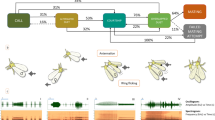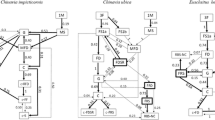Abstract
Male Nezara viridula emit a volatile sex pheromone that acts as a long-range attractant to females. Both sexes communicate through vibrations once they are on the same plant. Males respond to the female calling song by emitting a male courtship song, and they orient to the female calling song on a plant. Simultaneity between vibratory and chemical communication during the last steps of mate finding suggests that pheromone emission might be modulated by signals from conspecifics. Male volatile emissions were collected with fibers for solid-phase microextraction, while male bugs were stimulated with natural and artificial signals. Percentages of males releasing pheromone and collected amounts of pheromone increased when males were stimulated with female calling song. Pheromone emission was stable in males stimulated with male rivalry songs, and it decreased in males stimulated with a 100-Hz artificial signal. The ability of male bugs to modulate their pheromone emission may reduce metabolic costs, reduce parasitism, and offer a better synchronization of sexual activity.
Similar content being viewed by others
References
Aldrich, J. R. 1988. Chemical ecology of the heteroptera. Annu. Rev. Entomol. 33:211–238.
Aldrich, J. R., Lusby, W. R., Kochansky, J. P., and Lockwood, J. A. 1987. Pheromone strains of the cosmopolitan pest, Nezara viridula (Heteroptera: Pentatomidae). J. Exp. Zool. 244:171–175.
Baker, R., Borges, M., Cooke, N. G., and Herbert, R. H. 1987. Identification and synthesis of (Z)-(1′S, 3′R, 4′S)(−)-2–(3′,4′-epoxy-4′-methylcyclohexyl)-6–methylhepta-2,5–diene, the sex pheromone of the southern green stinkbug, Nezara viridula (L.). J. Chem. Soc., Chem. Commun. 1987:414–416.
Baker, T. C. and Cardé, R. T. 1979. Analysis of pheromone-mediated behaviors in male Grapholitha molesta, the oriental fruit moth (Lepidoptera: Tortricidae). Environ. Entomol. 8:956–968.
Borges, M. 1995. Attractant compounds of the southern green stink bug, Nezara viridula (L.) (Heteroptera: Pentatomidae). An. Soc. Entomol. Brasil 24:215–225.
Borges, M., Jepson, P. C., and Howse, P. E. 1987. Long-range mate location and close-range courtship behaviour of the green stink bug, Nezara viridula and its mediation by sex pheromones. Entomol. Exp. Appl. 44:205–212.
Brezot, P. 1994. La communication chimique chez Nezara viridula (L.) (Heteroptera: Pentatomidae): étude du signal phéromonal émis par les mâles. PhD. thesis. Université Pierre et Marie Curie, Paris, 120pp.
Brézot, P., Malosse, C., Mori, K., and Renou, M. 1994. Bisabolene epoxides in sex pheromone in Nezara viridula (L.) (Heteroptera: Pentatomidae): role of cis isomer and relation to specificity of pheromone. J. Chem. Ecol. 20:3133–3147.
čokl, A., Gogala, M., and Blazevic, A. 1978. Principles of sound recognition in three pentatomidae bug species. Biol. Vestn. 26:81–94.
čokl, A., Virant Doberlet, M., and McDowell, A. 1999. Vibrational directionality in the southern green stink bug Nezara viridula (L.), is mediated by female song. Anim. Behav. 58:1277–1283.
čokl, A., Virant Doberlet, M., and Stritih, N. 2000. The structure and function of songs emitted by southern green stink bugs from Brazil, Florida, Italy and Slovenia. Physiol. Entomol. 25:1–10.
čokl, A., McBrien, H. L., and Millar, J. G. 2001. Comparison of substrate-borne vibrational signals of two stink bug species, Acrosternum hilare and Nezara viridula. Ann. Entomol. Soc. Am. 94:471–479.
Harris, V. E. and Todd, J. W. 1980. Male mediated aggregation of male, female and 5th instar southern green stink bugs and concomitant attraction of a tachinid parasite. Trichopoda pennipes. Entomol. Exp. Appl. 27:117–126.
Harris, V. E., Todd, J. W., Webb, J. C., and Benner, J. C. 1982. Acoustical and behavioral analysis of the songs of the southern green stink bug. Nezara viridula. Ann. Entomol. Soc. Am. 75:234–249.
Kon, M., Oe, A., Numata, H., and Hidaka, T. 1988. Comparison of the mating behaviour between two sympatric species, Nezara antennata and N. viridula (Heteroptera: Pentatomidae), with special reference to sound emission. J. Ethol. 6:91–98.
Kon, M., Oe, A., and Numata, H. 1993. Intra-and interspecific copulations in the two congeneric green stink bugs, Nezara antennata and N. viridula (Heteroptera, Pentatomidae), with reference to postcopulatory changes in the spermatheca. J. Ethol. 11:83–89.
McBrien, H. L. and Millar, J. G. 1999. Phytophagous bugs, pp 277–303, in J. Hardie and A. K. Minks (Eds.) Pheromones of Non-lepidopteran Insects Associated with Agricultural Plants. CAB International, New York.
McLain, D. K. 1980. Female choice and the adaptative significance of prolonged copulation in Nezara viridula (Heteroptera: Pentatomidae). Psyche 87:325–336.
McLain, D. K. and Marsh, N. B. 1990. Male copulatory success: heritability and relationship to mate fecundity in the southern green stink bug, Nezara viridula (Heteroptera: Pentatomidae). Heredity 64:161–167.
McNeil, J. 1991. Behavioral ecology of pheromone-mediated communication in moths and its importance in the use of pheromone traps. Annu. Rev. Entomol. 36:407–430.
Miklas, N. 2002. Interactions et variations des signaux acoustiques et olfactifs lors de la rencontre des sexes chez Nezara viridula (Heteroptera, Pentatomidae). PhD thesis. Université Pierre et Marie Curie, Paris, 186pp.
Miklas, N., Renou, M., Malosse, I., and Malosse, C. 2000. Repeatability of pheromone blend composition in individual males of the southern green stink bug, Nezara viridula. J. Chem. Ecol. 26:2473–2485.
Miklas, N., Stritih, N., čokl, A., Virant-Doberlet, M., and Renou, M. 2001. The influence of substrate on male responsiveness to the female calling song in Nezara viridula. J. Insect Behav. 14:313–332.
Mitchell, W. C. and Mau, R. F. L. 1971. Response of the female southern green stink bug and its parasite, Trichopoda pennipes, to male stink bug pheromones. J. Econ. Entomol. 64:856–859.
Ota, D. and čokl, A. 1991. Mate location in the southern green stink bug, Nezara viridula (Heteroptera: Pentatomidae), mediated through substrate-borne signals on ivy. J. Insect Behav. 4:441–447.
Pavis, C. and Malosse, C. 1986. Mise en évidence d'un attractif sexuel produit par les mâles de Nezara viridula (L.). C.R. Acad. Sci. Paris 303:273–276.
Raina, A. K. 1997. Control of pheromone production in moths, pp. 21–30, in R. T. Cardé and A. K. Minks, (eds), Insect Pheromone Research. New Directions. Chapman & Hall, New York.
Rudinsky, J. A., Ryker, L. C., Michael, R. R., Libbey, L. M., and Morgan, M. E. 1976. Sound production in Scolytidae: female sonic stimulus of male pheromone release in two Dendroctonus beetles. J. Insect Physiol. 22:1675–1681.
Ryan, M. A. 1996. An investigation of discontinuities in the sexual behaviour of green vegetable bugs, Nezara viridula (Linnaeus) (Heteroptera: Pentatomidae). PhD thesis. University of Queensland, Queensland, 179pp.
Ryan, M. A., Moore, C. J., and Walter, G. H. 1995. Individual variation in pheromone composition in Nezara viridula (Heteroptera: Pentatomidae): How valid is the basis for designating “pheromone strains.”. Comp. Biochem. Physiol. 111:189–193.
Sokal, R. R. and Rohlf, F. J. 1969. The Principles and Practice of Statistics in Biological Research. W. H. Freeman, San Francisco, 250pp.
Spangler, H. G. 1987. Acoustically mediated pheromone release in Galleria mellonella (Lepidoptera: Pyralidae). J. Insect Physiol. 33:465–468.
Tomioka, H. and Mori, K. 1992. Simple synthesis of a diastereomeric mixture of 2–(3′,4′-epoxy-4′-methylcyclohexyl)-6–methyl-2,5–heptadiene, the pheromone of the green stink bug. Biosci. Biotech. Biochem. 56:1001.
Author information
Authors and Affiliations
Corresponding author
Rights and permissions
About this article
Cite this article
Miklas, N., Lasnier, T. & Renou, M. Male Bugs Modulate Pheromone Emission in Response to Vibratory Signals from Conspecifics. J Chem Ecol 29, 561–574 (2003). https://doi.org/10.1023/A:1022898620429
Issue Date:
DOI: https://doi.org/10.1023/A:1022898620429




